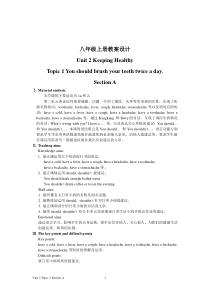 DOC
DOC
【文档说明】《Unit 2 Topic 1 You should brush your teeth twice a day》教案9-八年级上册英语仁爱(科普版).doc,共(7)页,107.000 KB,由小喜鸽上传
转载请保留链接:https://www.ichengzhen.cn/view-104936.html
以下为本文档部分文字说明:
Unit2Topic1SectionA1八年级上册教案设计Unit2KeepingHealthyTopic1Youshouldbrushyourteethtwiceaday.SectionAⅠ.Materi
alanalysis本节课的主要活动为1a和2。第二单元谈论如何保持健康。话题一介绍了感冒、头疼等常见病的名称,出现了疾病名称的词:toothache,backache,fever,cough,headache,stomachach
e等以及相对应的短语:haveacold,haveafever,haveacough,haveaheadache,haveatoothache,haveabackache,haveastomachache等。通过Kangkang和Betty的对话,呈现了
询问生病情况的对话:What’swrongwithyou?Ihavea…等,以及表达关心所提的建议:Youshould…和Youshouldn’t…。本课的语法重点是Youshould…和Youshouldn’t…。语
言功能方面要求学生学会用英语描述疾病并能就疾病征求他人意见、给他人提建议等。要求学生能在课后用英语写一篇描述疾病并提出有益建议的文章。Ⅱ.TeachingaimsKnowledgeaims:1.能正确运用以下短语进行书面表达:haveacold,haveafever,haveaco
ugh,haveaheadache,haveatoothache,haveabackache,haveastomachache等。2.能正确地运用should,shouldn’t提建议:Youshoulddrinkenoughboiledwater.You
shouldn’tdrinkcoffeeorteaintheevening.Skillaims:1.能听懂有关日常小病的名称及相关话题。2.能熟练地运用should,shouldn’t针对日常小病提建议。3.能正确朗读介绍日常小病的对话或文章。4.能用should,shouldn
’t结合本单元短语描述日常生活小病并提出有益的建议。Emotionalaims:通过语言学习,影响学生的自身品格,要学会信任他人、关心他人,为我们的健康生活创建友爱、和谐的氛围。Ⅲ.ThekeypointsanddifficultpointsKeypoints:haveacold,h
aveafever,haveacough,haveaheadache,haveatoothache,haveabackache,haveastomachache等短语的理解及运用。Difficultpoints:就日常小病用英语提建议。
Unit2Topic1SectionA2Ⅳ.Learningstrategies1.培养学生根据图片猜单词意思的能力。2.培养学生模仿已有例句造句的能力。Ⅴ.TeachingaidsComputermultimediaprojector,picturesofdifferentil
lnessesEverydaysaying:Bitterpillsmayhavewholesomeeffects.良药苦口利于病。Ⅵ.TeachingproceduresStepInteractionp
atternStudentactivityTeacheractivityIntroduction(7minutes)1.Thewholeclasswork2.Thewholeclasswork3.Individualworkandthewholec
lasswork4.Somestudents’work5.Thewholeclasswork1.Focustheirattentionontheteacher.2.Studentssingtogether.3.Monitorgivesthere
portwhiletheotherslistenandtrytounderstand.4.Volunteersanswer:(1)He/Shewantstobebeautiful;(2)Tobestrong;(3)Tobehea
lthy;5.Studentsfollowwhattheteachersays,andcomeintothenewtopicunconsciously.1.Getstudentsreadyforlearning.2.Singasongtogether.(C
lapyourhandsifyouarehappy.)TeachershowstheChinesewordsonthescreen.3.Dailyreport.TeacherasksmonitorofEnglishtogiveareportabout
“TheBeijingOlympics”.4.Teacherasksaquestion“Whydoes…likesports?”5.Theteacherleadstothenewtopic,“Yes,ifweexerciseeveryday,wewillbemore
beautiful,strongerandhealthier.Ifyoudon’ttakepartinanysportsactivities,youwillbeilllikethechildrenhere.”Unit2Topic1SectionA3Presentation
(10minutes)1.Thewholeclasswork2.Thewholeclasswork3.Pairwork4.Thewholeclasswork5.Thewholeclasswork6.Thewholeclasswork7.Thew
holeclasswork1.Studentsreadthewordsaccordingtothephoneticsymbolsandguessthemeaningsaccordingtothepictures.2.Studentstrytousetheverbphrasestoaskand
answertogether.3.Studentsaskandanswerinpairs,using“haveacough”,“haveaheadache”,and“haveatoothache”.4.Studentslookthrough1bandmakesuretheyknowwhat
todo.5.Studentslistencarefullyandfinish1b.6.Studentssaytheanswerstogetherandunderstandthemeaningof“suggestion”
withthehelpoftheteacher’sexplanation.7.Studentsfinish1c.1.Teacherpresentssomepicturesaboutthenewword
s:fever,cough,headacheandstomachache.Guidestudentstolearnthewordswiththephoneticsymbols,showingtheverbphrasesunderthepictures.2.Teacherasksandan
swersabout“haveafever”asamodelforthestudentstoimitate.A:What’sthematter?B:Hehasafever.3.Teacherintroduces“What’swrongwit
hhim/her?”tothestudentstodopairwork.4.Teacherleadsto1aforthestudentstofinish1b,saying“BettyandKangkangaretalkingaboutillness.Let’slistenandfinish1b.
First,youshouldlookthrough1bandmakesureyouknowwhattodo.”5.Teacherplays1a,andthenchecksthestudents’answers.6.Teachercheckstheanswersandteac
hestheword“suggestion”bypointingoutitssynonym“advice”.7.Teacherplays1cforthestudents.Unit2Topic1SectionA4C
onsolidation(10minutes)1.Thewholeclasswork2.Thewholeclassworkandpairwork3.Groupwork4.Thewholeclasswork5.Thew
holeclasswork6.Thewholeclasswork7.Thewholeclasswork8.Thewholeclasswork1.Studentsreadwiththerecording,imitatingi
t.2.Studentsaskandanswerinpairs.3.Studentsdochainpracticeingroups,makingsureeveryonecansaythedialoguecorrectly.4.Studentsdochainpracticeintheirgr
oupsasquicklyastheycan.5.Studentssaytheconclusionwiththeteacher.6.Studentslookatthepicturesandknowthemeaningsofthenewwords,
andthenpronouncethenewwordsaccordingtothepictures.7.Studentscatchthemeaningwhiledoingexercise2.8.Studentss
aytheanswerstogetherafterdiscussion.1.Teacherplays1aforthestudentstoreadwithoutstopping.2.Teacherasksthestudentstopractice“What’swrongwithyo
u?Ihavea…”inpairsaccordingto1c.3.Teacherasksthestudentstoaskandansweraccordingto1cingroups.4.Teacherasksthesixgroupstodochainpractice,andt
hefirstthreegroupswillwinthegame.5.Teachermakesaconclusion,“Whenwetalkaboutillness,wemayuse—What’swrongwith…?—…h
ave/hasa…”6.Teachershowspicturesofnewwordsonthescreen“coffee,tea,boiledwater”withphoneticsymbols.7.Teache
rexplainstheword“lift”bysayingitssynonym“carry”andasksthestudentstofinish2.8.Teacherchecksthestudents’answers.Unit2Topic1SectionA5Practice(
10minutes)1.Thewholeclasswork2.Groupworkandpairwork3.Twostudents’work4.Thewholeclasswork5.Thewholeclasswork6.Twostudents’work1.Studen
tsmakeupnewconversationsandtheymaydiscussingroups.2.Studentspreparefortheperformanceinpairs,andtworepresentativeswillbechosenout.
3.Thepairshoulddotheirbesttoperformwell.4.Studentsknowthemeaningsandthewaystoexpresssuggestions.5.Studentslistencarefullya
ndfinish3.6.Twovolunteerswritetheanswersontheblackboard.1.Teacherasksthestudentstomakeupnewconversationsaccordingto1cand2.2.Teacherasksthegroupswho
havelostthegameofpracticing1ctopracticetheirnewconversationsinpairs.Eachgroupfinishesonepair.3.Teacherasksthebest
pairtoshowtheconversationtothewholeclass.4.Teachershows“Youshould/Youshouldn’t…”ontheblackboard.5.Teacherplays3forthestudentstofinishAin3,andth
enplaysforthesecondtimeforthestudentstofinishBin3.6.Teachercheckstheanswers.Unit2Topic1SectionA6Production(8minutes)1.Thewhol
eclassworkandindividualwork2.Thewholeclasswork3.Thewholeclasswork4.Individualwork1.Eachstudentinterviewsonestudentandwritesdownthedialogue.2.
Studentswritetheirinterviewsdownafterclass,preparingforthereportinthenextclass.3.StudentssummarizeSectionAwiththeteacherbydoingexercis
esshownonthescreen.4.Studentsdothefollowingjobs:(1)Memorizethesummaryafterclass.(2)Studentswritetheinterview“What’swron
gwithyou?”afterclass,andthenprepareforthereportinthenextclass.(3)Studentslearntoreadvocabularywiththehelpofrecordingandt
hephoneticsymbols,andreadthedialogaftertherecording.1.Teacherorganizesaninterviewaccordingto1cand2,andstudentswilldoitintheirown
groups.2.Teacherasksthestudentstowritedowntheirinterviewsafterclass.3.Teachershowsthesummarytothestudents.(1)Vocabul
ary.(2)Thestructure:willdo.4.Teacherassignshomework:(1)Reviewthesummaryafterclass.(2)Reporttheirinterviewstothewholeclasstomorrow.(3)PrepareSect
ionBafterclass.TeachingReflectionIt’salittlehardforthestudentstogivepropersuggestionsonillness.Theymaysearchmoreinform
ationaboutthistopicafterclass.Unit2Topic1SectionA7Ⅶ.BlackboarddesignUnit2KeepingHealthyTopic1Youshouldbrush
yourteethtwiceaday.SectionAWhat’swrongwithyou?haveafever/coughIhaveabadcold.haveaheadache/stomachacheYoushouldseeadentist.drinken
oughwaterIhopeyou’llgetwellsoon.liftheavythings
 辽公网安备 21102102000191号
辽公网安备 21102102000191号
 营业执照
营业执照